
Here you can study for the exam. Look up keywords and learn definitions about all kind of subjects.
More subjects
The Asian green bee-eater (Merops orientalis), also known as little green bee-eater, and green bee-eater in Sri Lanka, is a near passerine bird in the bee-eater family. It is resident but prone to seasonal movements and is found widely distributed across Asia from coastal southern Iran east through the Indian subcontinent to Vietnam. Populations in Africa and the Arabian Peninsula that were formerly assigned to this species (under the name Green Bee-eater) are now considered distinct species. They are mainly insect eaters and they are found in grassland, thin scrub and forest often quite far from water. Several regional plumage variations are known and several subspecies have been named. (Source: Wikipedia.org, CC BY-SA)
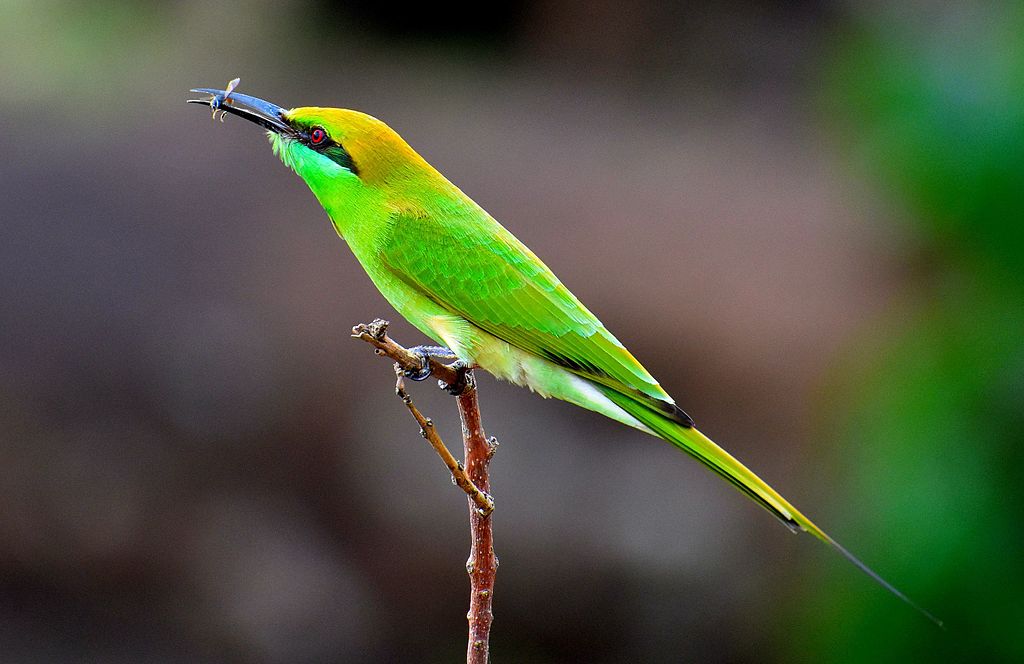 © Wikimedia.org/AshishTripurwar, CC BY-SA
© Wikimedia.org/AshishTripurwar, CC BY-SA
The green heron (Butorides virescens) is a small heron of North and Central America. Butorides is from Middle English butor 'bittern' and Ancient Greek -oides, 'resembling', and virescens is Latin for 'greenish'. It was long considered conspecific with its sister species the striated heron (Butorides striata), and together they were called 'green-backed heron'. Birds of the nominate subspecies (no matter which taxonomic arrangement is preferred) are extremely rare vagrants to western Europe—for example, a sighting in Pembrokeshire in 2018 was only the second recorded sighting in Wales; individuals from the Pacific coast of North America may similarly stray as far as Hawaii. (Source: Wikipedia.org, CC BY-SA)
The grey heron (Ardea cinerea) is a long-legged wading bird of the heron family, Ardeidae, native throughout temperate Europe and Asia and also parts of Africa. It is resident in much of its range, but some populations from the more northern parts migrate southwards in autumn. A bird of wetland areas, it can be seen around lakes, rivers, ponds, marshes and on the sea coast. It feeds mostly on aquatic creatures which it catches after standing stationary beside or in the water or stalking its prey through the shallows. (Source: Wikipedia.org, CC BY-SA)
The Eurasian griffon vulture (Gyps fulvus) is a large Old World vulture in the bird of prey family Accipitridae. It may also be known as the Griffon vulture, though it may be used for the genus as a whole. It is not to be confused with Rüppell's griffon vulture (Gyps rueppellii). It is closely related to the white-backed vulture (Gyps africanus). The griffon vulture is 93–122 cm (37–48 in) long with a 2.3–2.8 m (7.5–9.2 ft) wingspan. In the nominate race the males weigh 6.2 to 10.5 kg (14 to 23 lb) and females typically weigh 6.5 to 10.5 kg (14 to 23 lb), while in the Indian subspecies (G. f. fulvescens), the vultures average 7.1 kg (16 lb). (Source: Wikipedia.org, CC BY-SA)
Grouse /ɡraʊs/ are a group of birds from the order Galliformes, in the family Phasianidae. Grouse are presently assigned to the tribe Tetraonini (formerly the subfamily Tetraoninae and the family Tetraonidae), a classification supported by mitochondrial DNA sequence studies, and applied by the American Ornithologists' Union, ITIS, International Ornithological Congress, and others. Grouse inhabit temperate and subarctic regions of the Northern Hemisphere, from pine forests to moorland and mountainside, from 83°N (rock ptarmigan in northern Greenland) to 28°N (Attwater's prairie chicken in Texas). Turkeys are closely related to grouse and are also classified in the tribe Tetraonini. The koklass pheasant is also closely allied with them. (Source: Wikipedia.org, CC BY-SA)
Guineafowl (/ˈɡɪnifaʊl/; sometimes called 'pet speckled hens' or 'original fowl') are birds of the family Numididae in the order Galliformes. They are endemic to Africa and rank among the oldest of the gallinaceous birds. Phylogenetically, they branched off from the core Galliformes after the Cracidae (chachalacas, guans, and curassows) and before the Odontophoridae (New World quail). An Eocene fossil lineage Telecrex has been associated with guineafowl; Telecrex inhabited Mongolia, and may have given rise to the oldest of the true phasianids, such as blood pheasants and eared pheasants, which evolved into high-altitude, montane-adapted species with the rise of the Tibetan Plateau. While modern guineafowl species are endemic to Africa, the helmeted guineafowl has been introduced as a domesticated bird widely elsewhere. (Source: Wikipedia.org, CC BY-SA)
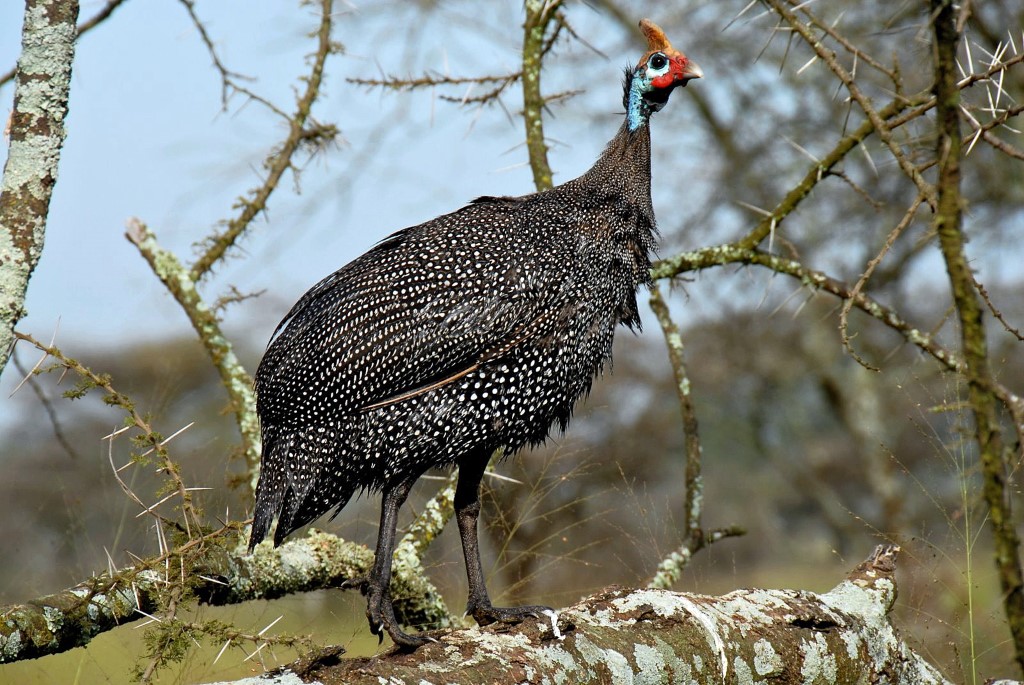 © Wikimedia.org/Bob, CC BY
© Wikimedia.org/Bob, CC BY
The harpy eagle (Harpia harpyja) is a neotropical species of eagle. It is also called the American harpy eagle to distinguish it from the Papuan eagle, which is sometimes known as the New Guinea harpy eagle or Papuan harpy eagle. It is the largest and most powerful raptor found throughout its range, and among the largest extant species of eagles in the world. It usually inhabits tropical lowland rainforests in the upper (emergent) canopy layer. Destruction of its natural habitat has caused it to vanish from many parts of its former range, and it is nearly extirpated from much of Central America. In Brazil, the harpy eagle is also known as royal-hawk (in Portuguese: gavião-real). The genus Harpia, together with Harpyopsis and Morphnus, form the subfamily Harpiinae. (Source: Wikipedia.org, CC BY-SA)
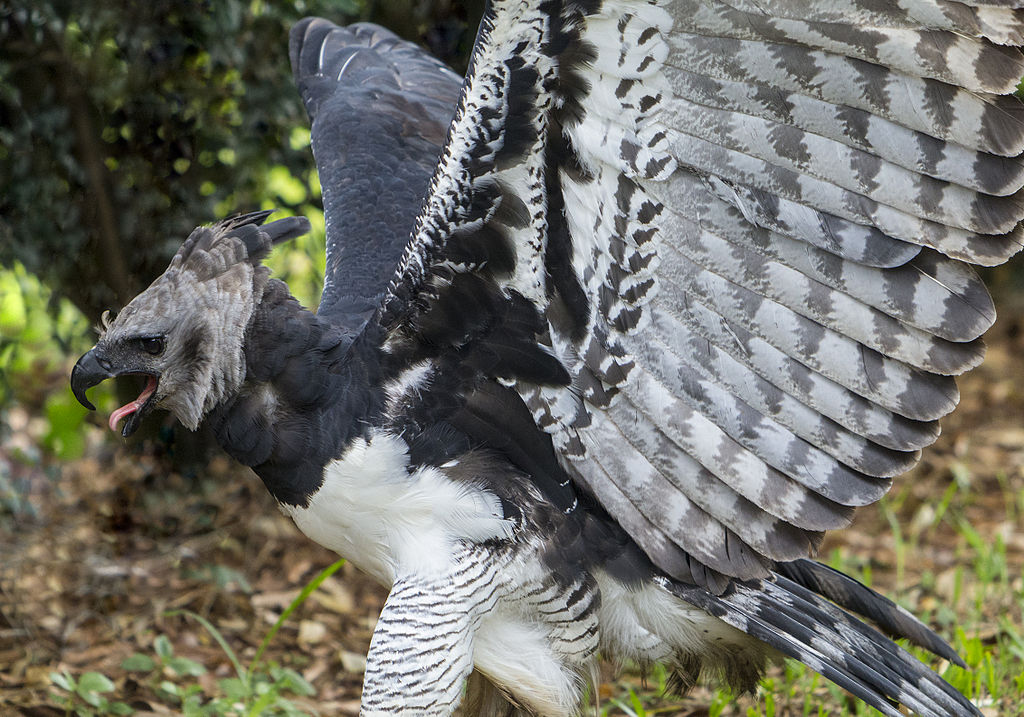 © Wikimedia.org/Jonathan Wilkins, CC BY-SA
© Wikimedia.org/Jonathan Wilkins, CC BY-SA
The Harris's hawk (Parabuteo unicinctus), formerly known as the bay-winged hawk, dusky hawk, and sometimes a wolf hawk, and known in Latin America as peuco, is a medium-large bird of prey that breeds from the southwestern United States south to Chile, central Argentina, and Brazil. Birds are sometimes reported at large in Western Europe, especially Britain, but it is a popular species in falconry and these records almost invariably all refer to escapes from captivity. The Harris's hawk is notable for its behavior of hunting cooperatively in packs consisting of tolerant groups, while other raptors often hunt alone. Harris hawks' social nature has been attributed to their intelligence, which makes them easy to train and have made them a popular bird for use in falconry. (Source: Wikipedia.org, CC BY-SA)
The Hawaiian crow or ʻalalā (Corvus hawaiiensis) is a species of bird in the crow family, Corvidae, that is currently extinct in the wild, though reintroduction programs are underway. It is about the size of the carrion crow at 48–50 cm (19–20 in) in length, but with more rounded wings and a much thicker bill. It has soft, brownish-black plumage and long, bristly throat feathers; the feet, legs and bill are black. Today, the Hawaiian crow is considered the most endangered of the family Corvidae. They are recorded to have lived up to 18 years in the wild, and 28 years in captivity. Some Native Hawaiians consider the Hawaiian crow an ʻaumakua (family god). (Source: Wikipedia.org, CC BY-SA)
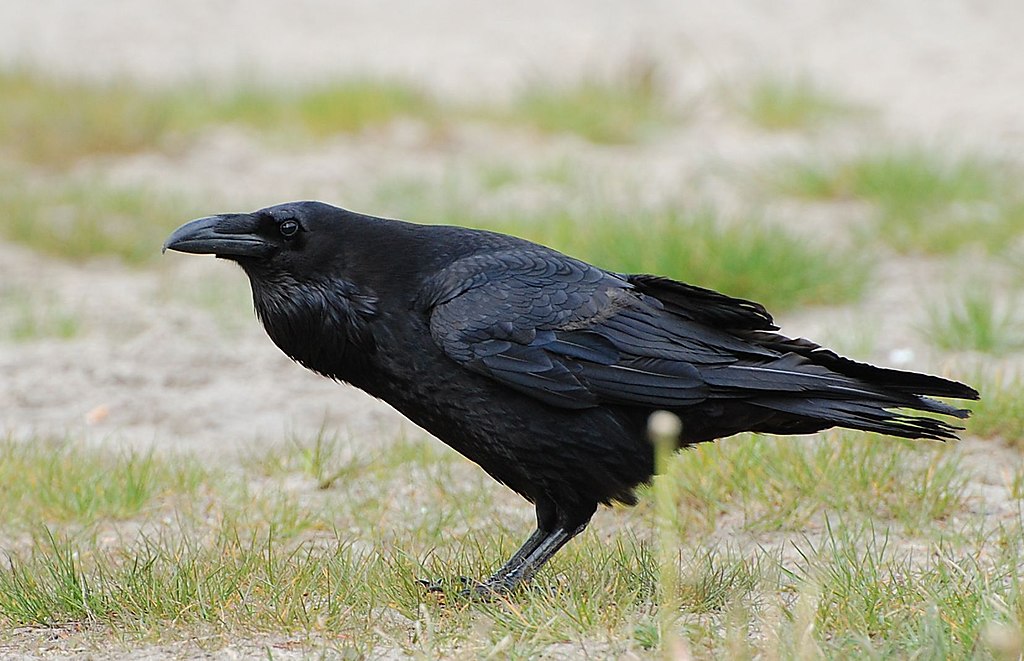 © Wikimedia.org/R. Altenkamp, CC BY-SA
© Wikimedia.org/R. Altenkamp, CC BY-SA
The nene (Branta sandvicensis), also known as the nēnē or the Hawaiian goose, is a species of bird endemic to the Hawaiian Islands. The nene is exclusively found in the wild on the islands of Oahu, Maui, Kauaʻi, Molokai, and Hawaiʻi. In 1957, it was designated as the official state bird of state of Hawaiʻi. The Hawaiian name nēnē comes from its soft call. The specific name sandvicensis refers to the Sandwich Islands, a former name for the Hawaiian Islands. (Source: Wikipedia.org, CC BY-SA)
Hawks are birds of prey of the family Accipitridae. They are widely distributed and are found on all continents except Antarctica. A hawk's diet is predictable and includes a variety of smaller animals. Some of these small animals include snakes, lizards, fish, mice, rabbits, squirrels, birds, and any other type of small game that is found on the ground. More specifically, a red-shouldered hawk likes to eat smaller birds like doves and bugs like grasshoppers and crickets. (Source: Wikipedia.org, CC BY-SA)
The herons are long-legged, long-necked, freshwater and coastal birds in the family Ardeidae, with 72 recognised species, some of which are referred to as egrets or bitterns rather than herons. Members of the genera Botaurus and Ixobrychus are referred to as bitterns, and, together with the zigzag heron, or zigzag bittern, in the monotypic genus Zebrilus, form a monophyletic group within the Ardeidae. Egrets do not form a biologically distinct group from herons, and tend to be named differently because they are mainly white or have decorative plumes in breeding plumage. Herons, by evolutionary adaptation, have long beaks. (Source: Wikipedia.org, CC BY-SA)
The hoatzin (/hoʊˈætsɪn/ hoh-AT-sin) or hoactzin (/hoʊˈæktsɪn/ hoh-AKT-sin), (Opisthocomus hoazin), is the only species in the order Opisthocomiformes. It is a species of tropical bird found in swamps, riparian forests, and mangroves of the Amazon and the Orinoco basins in South America. It is notable for having chicks that have claws on two of their wing digits. It is the only member of the genus Opisthocomus (Ancient Greek: 'long hair behind', referring to its large crest). This is the only extant genus in the family Opisthocomidae. The taxonomic position of this family has been greatly debated by specialists, and is still far from clear. (Source: Wikipedia.org, CC BY-SA)
The European honey buzzard (Pernis apivorus), also known as the pern or common pern, is a bird of prey in the family Accipitridae. The 52–60-centimetre (20–24 in)-long honey buzzard is larger and longer winged, with a 135–150-centimetre (53–59 in) wingspan, when compared to the smaller common buzzard (Buteo buteo). It appears longer necked with a small head, and soars on flat wings. It has a longer tail, which has fewer bars than the Buteo buzzard, usually with two narrow dark bars and a broad dark subterminal bar. The sexes can be distinguished on plumage, which is unusual for a large bird of prey. The male has a blue-grey head, while the female's head is brown. The female is slightly larger and darker than the male. (Source: Wikipedia.org, CC BY-SA)
The hooded oriole (Icterus cucullatus) is a medium-sized New World oriole. The male of this species ranges in color from a bright orange to a paler yellow, with a black back, face, tail and bib, with the wing containing two white bars. The female is more of an olive color with some yellow accents. Adults have a curved bill which is completely black and white wing bars. The adult male has a deep yellowish orange head with black on the face and throat; they are black on the back, wings and tail, orange on the underparts. The adult female is olive-green on the upper parts, yellowish on the breast and belly. Their calls consist of whistling and wheets, while their song is a mixture of both. (Source: Wikipedia.org, CC BY-SA)
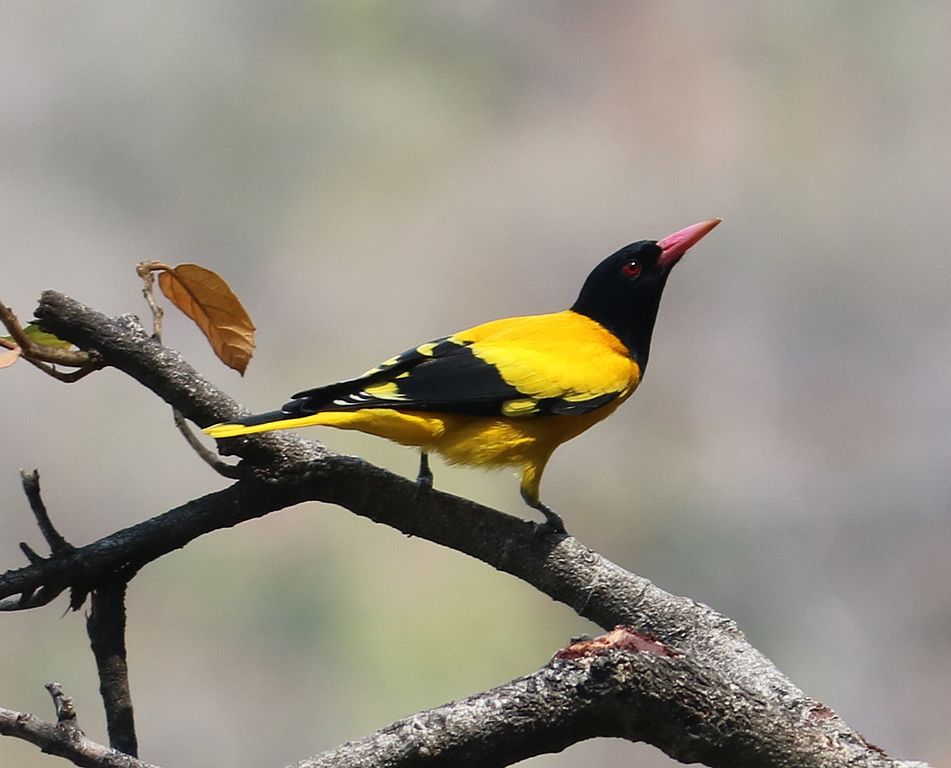 © Wikimedia.org/Chitrashanker, CC BY-SA
© Wikimedia.org/Chitrashanker, CC BY-SA
Hoopoes (/ˈhuːpuː/) are colourful birds found across Africa, Asia, and Europe, notable for their distinctive 'crown' of feathers. Three living and one extinct species are recognized, though for many years all of the extinct species were lumped as a single species—Upupa epops. In fact, some taxonomists still consider all three species conspecific. Some authorities also keep the African and Eurasian hoopoe together but split the Madagascar hoopoe. The Eurasian hoopoe is common in its range and has a large population, so it is evaluated as Least Concern on The IUCN Red List of Threatened Species. However, their numbers are declining in Western Europe. Conversely, the hoopoe has been increasing in numbers at the tip of the South Sinai, Sharm el-Sheikh. There are dozens of nesting pairs that remain resident all year round. (Source: Wikipedia.org, CC BY-SA)
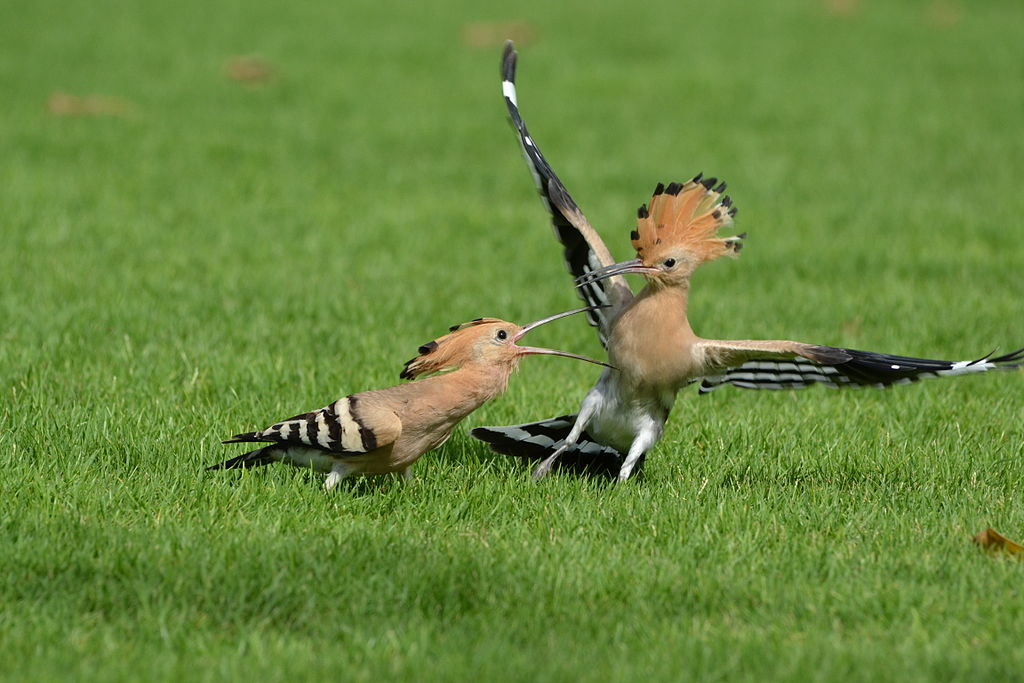 © Wikimedia.org/Jaiprakashsingh, CC BY-SA
© Wikimedia.org/Jaiprakashsingh, CC BY-SA
Hornbills (Bucerotidae) are a family of bird found in tropical and subtropical Africa, Asia and Melanesia. They are characterized by a long, down-curved bill which is frequently brightly coloured and sometimes has a casque on the upper mandible. Both the common English and the scientific name of the family refer to the shape of the bill, 'buceros' being 'cow horn' in Greek. Hornbills have a two-lobed kidney. They are the only birds in which the first and second neck vertebrae (the atlas and axis respectively) are fused together; this probably provides a more stable platform for carrying the bill. The family is omnivorous, feeding on fruit and small animals. They are monogamous breeders nesting in natural cavities in trees and sometimes cliffs. A number of mainly insular species of hornbill with small ranges are threatened with extinction, namely in Southeast Asia. (Source: Wikipedia.org, CC BY-SA)
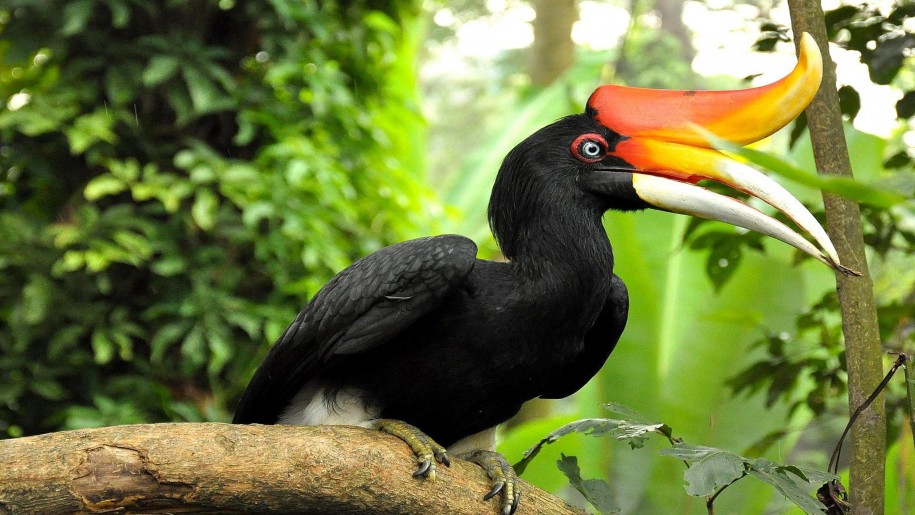 © Wikimedia.org/Alok sahil, CC BY-SA
© Wikimedia.org/Alok sahil, CC BY-SA
The house finch (Haemorhous mexicanus) is a bird in the finch family Fringillidae. It is native to western North America and has been introduced to the eastern half of the continent and Hawaii. This species and the other American rosefinches are placed in the genus Haemorhous. Adults have a long, square-tipped brown tail and are a brown or dull-brown color across the back with some shading into deep gray on the wing feathers. Breast and belly feathers may be streaked; the flanks usually are. In most cases, adult males' heads, necks and shoulders are reddish. (Source: Wikipedia.org, CC BY-SA)
The house sparrow (Passer domesticus) is a bird of the sparrow family Passeridae, found in most parts of the world. It is a small bird that has a typical length of 16 cm (6.3 in) and a mass of 24–39.5 g (0.85–1.39 oz). Females and young birds are coloured pale brown and grey, and males have brighter black, white, and brown markings. One of about 25 species in the genus Passer, the house sparrow is native to most of Europe, the Mediterranean Basin, and a large part of Asia. Its intentional or accidental introductions to many regions, including parts of Australasia, Africa, and the Americas, make it the most widely distributed wild bird. (Source: Wikipedia.org, CC BY-SA)
The house wren (Troglodytes aedon) is a very small bird of the wren family, Troglodytidae. It occurs from Canada to southernmost South America, and is thus the most widely distributed native bird in the Americas. It occurs in most suburban areas in its range and it is the single most common wren. Its taxonomy is highly complex and some subspecies groups are often considered separate species. The name troglodytes means 'hole dweller', and is a reference to bird's tendency to disappear into crevices when hunting insects or to seek shelter. (Source: Wikipedia.org, CC BY-SA)
The Humboldt penguin (Spheniscus humboldti) is a medium-sized penguin. It resides in South America, its range mainly contains most of coastal Peru. Its nearest relatives are the African penguin, the Magellanic penguin and the Galápagos penguin. The Humboldt penguin and the cold water current it swims in both are named after the explorer Alexander von Humboldt. The species is listed as vulnerable by the IUCN with no population recovery plan in place. The current population is composed of 32,000 mature individuals and is going down. It is a migrant species. (Source: Wikipedia.org, CC BY-SA)
Hummingbirds are birds native to the Americas and comprise the biological family Trochilidae. With about 361 species and 113 genera, they occur from Alaska to Tierra del Fuego, but the vast majority of the species are found in the tropics around the equator. They are small birds, with most species measuring 7.5–13 cm (3–5 in) in length. The smallest extant hummingbird species is the 5 cm (2.0 in) bee hummingbird, which weighs less than 2.0 g (0.07 oz). The largest hummingbird species is the 23 cm (9.1 in) giant hummingbird, weighing 18–24 grams (0.63–0.85 oz). They are specialized for feeding on flower nectar, but all species also consume flying insects or spiders. (Source: Wikipedia.org, CC BY-SA)
The ibises (/ˈaɪbɪs/) (collective plural ibis; classical plurals ibides and ibes) are a group of long-legged wading birds in the family Threskiornithidae, that inhabit wetlands, forests and plains. 'Ibis' derives from the Latin and Ancient Greek word for this group of birds. It also occurs in the scientific name of the cattle egret (Bubulcus ibis) mistakenly identified in 1757 as being the sacred ibis. (Source: Wikipedia.org, CC BY-SA)
Jacana is the genus comprising the two jacanas of the Americas: the northern jacana, Jacana spinosa, and the wattled jacana, Jacana jacana. The two species are very similar to each other: about 22 cm (8.7 in) long, with long necks and fairly long yellow bills. Adults are black and chestnut-brown, with pale yellow-green flight feathers that contrast conspicuously when a bird flies. Their legs are long and grayish, and as in all jacanas, their toes are extremely long for walking on aquatic vegetation such as lily pads. They have frontal shields (like those of coots) and wattles; differences in these are the most noticeable differences between the species. Juveniles are brown above and white below, with a buff-white stripe above the eye and a dark stripe behind it. The dark colors are somewhat darker on the juvenile wattled jacana than on the northern. (Source: Wikipedia.org, CC BY-SA)
Jackdaws are two species of bird in the genus Coloeus closely related to, but generally smaller than, the crows and ravens (Corvus). Coloeus is sometimes treated as a subgenus of Corvus, including by the IUCN. They have a blackish crown, wings and tail, the rest of the plumage being paler. The word Coloeus is New Latin, from the Ancient Greek for jackdaws: koloiós (κολοιός). (Source: Wikipedia.org, CC BY-SA)
A jay is a member of a number of species of medium-sized, usually colorful and noisy, passerine birds in the Crow family, Corvidae. The evolutionary relationships between the jays and the magpies are rather complex. For example, the Eurasian magpie seems more closely related to the Eurasian jay than to the East Asian blue and green magpies, whereas the blue jay is not closely related to either. (Source: Wikipedia.org, CC BY-SA)
Junglefowl are the only four living species of bird from the genus Gallus in the bird order Galliformes, and occur in parts of South and Southeast Asia. They diverged from their common ancestor about 4–6 million years ago. Although originating in Asia, remains of junglefowl bones have also been found in regions of Chile, which date back to 1321–1407 CE, providing evidence of possible Polynesian migration through the Pacific Ocean. These are large birds, with colourful plumage in males, but are nevertheless difficult to see in the dense vegetation they inhabit. (Source: Wikipedia.org, CC BY-SA)
The kākāpō (/ˈkɑːkəpoʊ/ KAH-kə-poh; Māori: [kaːkaːpɔː]; from the Māori: kākāpō, lit. 'night parrot'), also known as owl parrot (Strigops habroptilus), is a species of large, flightless, nocturnal, ground-dwelling parrots of the super-family Strigopoidea, endemic to New Zealand. Up to 64 cm (25 in) in length, these flightless birds have finely blotched yellow-green plumage, a distinct facial disc, owl-style forward-facing eyes with surrounding discs of specially-textured feathers, a large grey beak, short legs, large blue feet, and relatively short wings and tail: a combination of traits making it unique among parrots. It is the world's only flightless parrot, the world's heaviest parrot, and also is nocturnal, herbivorous, visibly sexually dimorphic in body size, has a low basal metabolic rate, and does not have male parental care. It is the only parrot to have a polygynous lek breeding system. It is also possibly one of the world's longest-living birds, with a reported lifespan of up to 100 years. (Source: Wikipedia.org, CC BY-SA)
The keel-billed toucan (Ramphastos sulfuratus), also known as sulfur-breasted toucan or rainbow-billed toucan, is a colorful Latin American member of the toucan family. It is the national bird of Belize. The species is found in tropical jungles from southern Mexico to Colombia. It is an omnivorous forest bird that feeds on fruits, seeds, insects, invertebrates, lizards, snakes, and small birds and their eggs. (Source: Wikipedia.org, CC BY-SA)
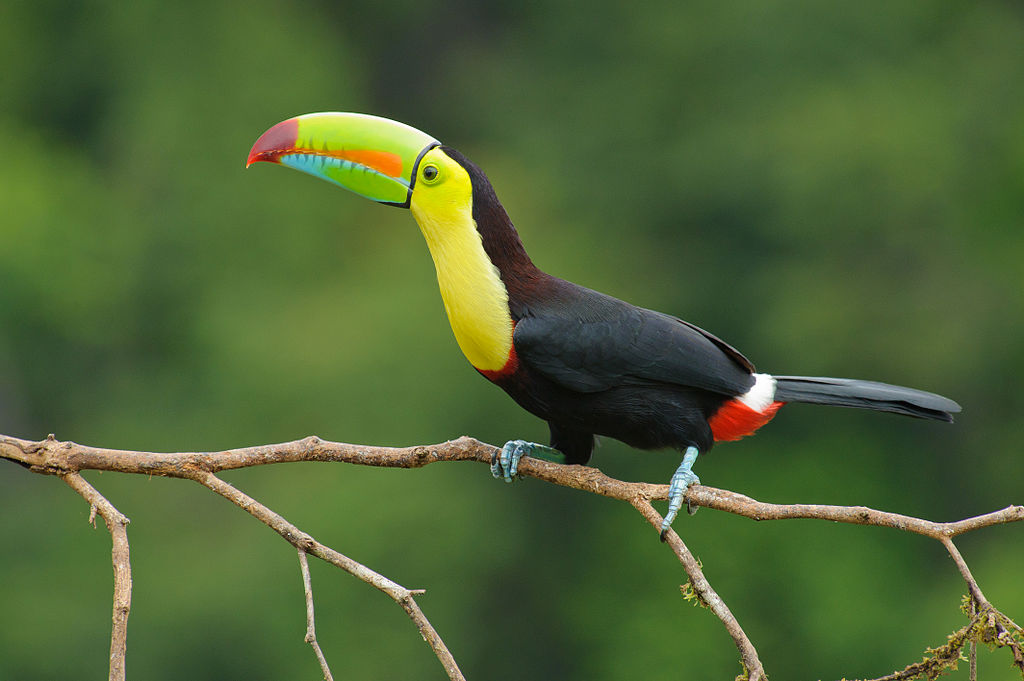 © Wikimedia.org/Ttschleuder, CC BY-SA
© Wikimedia.org/Ttschleuder, CC BY-SA
The term kestrel (from French: crécerelle, derivative from crécelle, i.e. ratchet) is the common name given to several species of predatory birds from the falcon genus Falco. Kestrels are most easily distinguished by their typical hunting behaviour which is to hover at a height of around 10–20 metres (35–65 ft) over open country and swoop down on ground prey, usually small mammals, lizards or large insects, while other falcons are more adapted for active hunting during flight. Kestrels are notable for usually having mostly brown in their plumage.[citation needed] (Source: Wikipedia.org, CC BY-SA)
The killdeer (Charadrius vociferus) is a large plover found in the Americas. It was described and given its current scientific name in 1758 by Carl Linnaeus in the 10th edition of his Systema Naturae. Three subspecies are described. The killdeer's common name comes from its often-heard call. Its upperparts are mostly brown with rufous fringes, the head has patches of white and black, and two black bands cross the breast. The belly and the rest of the breast are white. The nominate (or originally described) subspecies breeds from southeastern Alaska and southern Canada to Mexico. It is seen year-round in the southern half of its breeding range; the subspecies C. v. ternominatus is probably resident in the West Indies, and C. v. peruvianus inhabits Peru and areas of the surrounding countries throughout the year. North American breeders winter from their resident range south to Central America, the West Indies, and the northernmost portions of South America. (Source: Wikipedia.org, CC BY-SA)
The king penguin (Aptenodytes patagonicus) is the second largest species of penguin, smaller, but somewhat similar in appearance to the emperor penguin. There are two subspecies: A. p. patagonicus and A. p. halli; patagonicus is found in the South Atlantic and halli in the South Indian Ocean (at the Kerguelen Islands, Crozet Island, Prince Edward Islands and Heard Island and McDonald Islands) and at Macquarie Island. King penguins mainly eat lanternfish, squid and krill. On foraging trips, king penguins repeatedly dive to over 100 metres (300 ft), and have been recorded at depths greater than 300 metres (1,000 ft). Predators of the king penguin include giant petrels, skuas, the snowy sheathbill, the leopard seal and the orca. (Source: Wikipedia.org, CC BY-SA)
The king vulture (Sarcoramphus papa) is a large bird found in Central and South America. It is a member of the New World vulture family Cathartidae. This vulture lives predominantly in tropical lowland forests stretching from southern Mexico to northern Argentina. It is the only surviving member of the genus Sarcoramphus, although fossil members are known. Large and predominantly white, the king vulture has gray to black ruff, flight, and tail feathers. The head and neck are bald, with the skin color varying, including yellow, orange, blue, purple, and red. The king vulture has a very noticeable orange fleshy caruncle on its beak. This vulture is a scavenger and it often makes the initial cut into a fresh carcass. It also displaces smaller New World vulture species from a carcass. King vultures have been known to live for up to 30 years in captivity. (Source: Wikipedia.org, CC BY-SA)
Tyrannus is a genus of small passerine birds of the tyrant flycatcher family. The majority are named as kingbirds. They prefer semi-open or open areas. These birds wait on an exposed perch and then catch insects in flight. They have long pointed wings and large broad bills. These birds tend to defend their breeding territories aggressively, often chasing away much larger birds. A kingbird was photographed in 2009 defending its young by landing on and sinking its talons into the back of a red-tailed hawk and pecking its skull until the red-tailed hawk gave up and flew away. (Source: Wikipedia.org, CC BY-SA)
Kingfishers are a family, the Alcedinidae, of small to medium-sized, brightly colored birds in the order Coraciiformes. They have a cosmopolitan distribution, with most species found in the tropical regions of Africa, Asia, and Oceania, but also can be seen in Europe. They can be found in deep forests near calm ponds and small rivers. The family contains 114 species and is divided into three subfamilies and 19 genera. All kingfishers have large heads, long, sharp, pointed bills, short legs, and stubby tails. Most species have bright plumage with only small differences between the sexes. Most species are tropical in distribution, and a slight majority are found only in forests. (Source: Wikipedia.org, CC BY-SA)
A kite is a tethered heavier-than-air or lighter-than-air craft with wing surfaces that react against the air to create lift and drag forces. A kite consists of wings, tethers and anchors. Kites often have a bridle and tail to guide the face of the kite so the wind can lift it. Some kite designs don’t need a bridle; box kites can have a single attachment point. A kite may have fixed or moving anchors that can balance the kite. The name is derived from kite, the hovering bird of prey. (Source: Wikipedia.org, CC BY-SA)
Kiwi (/ˈkiːwiː/ KEE-wee) are flightless birds endemic to New Zealand of the genus Apteryx (/ˈæptərɪks/) and family Apterygidae (/ˌæptəˈrɪdʒədiː/). Approximately the size of a domestic chicken, kiwi are by far the smallest living ratites (which also include ostriches, emus, rheas and cassowaries). DNA sequence comparisons have yielded the conclusion that kiwi are much more closely related to the extinct Malagasy elephant birds than to the moa with which they shared New Zealand. There are five recognised species, four of which are currently listed as vulnerable, and one of which is near-threatened. All species have been negatively affected by historic deforestation, but their remaining habitat is well-protected in large forest reserves and national parks. At present, the greatest threat to their survival is predation by invasive mammalian predators. (Source: Wikipedia.org, CC BY-SA)
Kookaburras are terrestrial tree kingfishers of the genus Dacelo native to Australia and New Guinea, which grow to between 28 and 47 cm (11 and 19 in) in length and weigh around 300 g (11 oz). The name is a loanword from Wiradjuri guuguubarra, onomatopoeic of its call. The loud, distinctive call of the laughing kookaburra is widely used as a stock sound effect in situations that involve an Australian bush setting or tropical jungle, especially in older movies. They are found in habitats ranging from humid forest to arid savannah, as well as in suburban areas with tall trees or near running water. Though they belong to the larger group known as 'kingfishers', kookaburras are not closely associated with water. (Source: Wikipedia.org, CC BY-SA)
The kori bustard (Ardeotis kori) is the largest flying bird native to Africa. It is a member of the bustard family, which all belong to the order Otidiformes and are restricted in distribution to the Old World. It is one of the four species (ranging from Africa to India to Australia) in the large-bodied genus Ardeotis. In fact, the male kori bustard may be the heaviest living animal capable of flight. (Source: Wikipedia.org, CC BY-SA)
The lappet-faced vulture or Nubian vulture (Torgos tracheliotos) is an Old World vulture belonging to the bird order Accipitriformes, which also includes eagles, kites, buzzards and hawks. It is the only member of the genus Torgos. It is not closely related to the superficially similar New World vultures, and does not share the good sense of smell of some members of that group. The lappet-faced vulture was formerly considered monotypical, but now is separated into two subspecies. The nominate race lives throughout Africa. The subspecies T. t. negevensis, differing considerably in appearance from African vultures (as described below) is endemic to the Arabian peninsula. (Source: Wikipedia.org, CC BY-SA)

Time for recess! Post a comment, ask a question or write a review. Feel free to let us know what you think!
Want even more practice? Visit similar websites offering realistic practice driving knowledge tests. Visit us to see what sets our tests apart! https://dkttest.com/capital-territory/
Cool tool! And fun to check whether I remember the rules :) Two things I noticed: Warning for a crossroad side roads on the left and right. While technically that might be the correct translation, this sign tells you, that you are on the main road and have the right of way for the next crossroad and only the next crossroad. Usually (if no sign specifies otherwise) you have to give way to drivers coming from the right at every intersection, which can get a bit annoying in communal areas, so seeing this sign feels less like a warning and more like relief :). A Fahrradstraße is not a lane for cyclists but a street for cyclists, meaning the (whole!) street is intended predominantly for cyclists, who are then allowed to ride next to each other. Cars are allowed to drive there (unless another sign prohibits such), but have to adjust their speed to the cyclists. I believe they are not allowed to pass at all, even if the oncoming lane is empty.
this website is a simpy website i love this its fat and im in my mums basement rn help sui u r a mothr fker
Hi i am such fat fan of this great gaming website. Im so hangry for the cause mate! Liking the simps eating on yall tho nott gonna lie to ya!
The system is now changed and they use some type of tablet for the exam now. Do anyone have the questions which they ask in the tablet because the questions are different. I still didn’t pass my provisional driving knowledge test. It would be great if someone could help
Good exercise !! Looking for some drift friends, hit to my email Funnyparts@gmail.com
The exercise of the activity of TVDE driver, without it being registered on an electronic platform, incurs:
Who will be responsible for infractions that may be committed and for damages caused to third parties, without prejudice to the corresponding administrative sanctions:
This answer is incorrect. What does this traffic sign mean? Square sign with a circular not parking inside. Choices: Begin of a zone where parking is allowed, Being of a zone with a speed limit, Begin of zone where parking is prohibited, Begin of a residential area. The correct answer should be Begin of a zone where parking is allowed NOT Begin of zone where parking is prohibited. It is a Controlled parking Zone.
Hi! Anyone please suggest me some personal driving tutors in Vantaa for few days.
More community